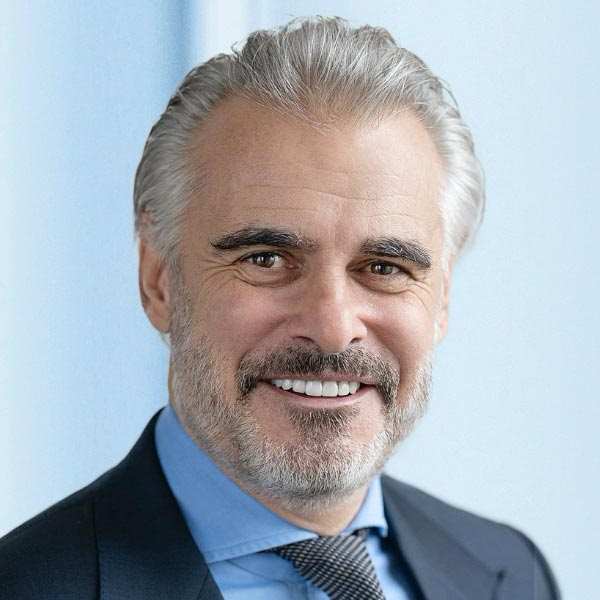A Conversation With David Henderson

David Henderson
Chief Human Resources Officer for Zurich Insurance Group
CliftonStrengths Top 5: Responsibility | Harmony | Consistency | Arranger | Significance
Zurich Insurance Group, the 55,000-employee, global multi-line insurer, has made some unusual hires lately, bringing in talent from P&G, Amazon and The LEGO Group.
It's part of a strategy of careful disruption that Zurich's CHRO, David Henderson, kicked off on his arrival in 2017. At the time, Zurich was beginning a transformation of its digital and customer relationship approach, and talent from outside the insurance industry was key to that transformation. "Your current talent has gotten you to where you are at that moment," Henderson says, "but is unlikely to get you to where you need to go."
The process began with an examination of around 600 roles -- from CEO, going down three levels -- to decide which of those roles required deep technical expertise from inside the insurance sector and which needed a fresh outlook. That led to a whole new talent model (Henderson says the traditional nine-box "gives you false precision" that makes managers obsess over low-value decisions) and development approach to create a simpler, more customer-centric, digitally enhanced business.
Four years later, Henderson says the process wasn't easy or painless -- but, as he explains in this CHRO Conversation, those unusual hires provided the disruptive talent Zurich's strategy needed to deliver for customers, shareholders and employees.
Emond: You have a unique approach to disruption: talent first, strategy second. How did you arrive at that?
Henderson: If your organization has to go on a very different strategic path, you're very unlikely to concretely dimensionalize that strategy with your existing talent, right? So you really have to have a catalyst to implement a disruptive strategy. Your current talent has gotten you to where you are at that moment, but is unlikely to get you to where you need to go. With my apologies to Peter Drucker, I'd say, "Talent eats strategy for breakfast." To write a new strategic plan as truly disruptive as ours was, the last place you should start with is your existing talent. You should start by augmenting the talent you have with the talent you need and then engage this team in the strategic planning process. Professional talent runs the business, and disruptors change the business. You need both in a high-change environment. So that was the starting point of "talent first, strategy second." It's not that linear in practice, of course, but the principle holds true.
"Your current talent has gotten you to where you are at that moment, but is unlikely to get you to where you need to go."
Emond: What did you want to disrupt?
Henderson: The insurance industry tends to hire from within, which can make it overly homogenous and too inward-looking. Typically, it is an industry that has not embraced a lot of external perspectives and analogous learnings. That became a huge issue for us in terms of the digital and customer transformation, starting when our CEO, Mario Greco, arrived in Zurich in 2016. He took the lead in a company that needed to shift direction quite profoundly in order to be relevant and successful in the marketplace -- which is why we realized we needed to bring in talent and infuse it with existing expertise.
One of our signature actions in 2017 was assembling the talent that we needed to write and then execute the three-year strategic plan through 2020. Now, that's not to say we didn't have an idea of the strategic direction we wanted to go in. We knew we wanted to be a simpler, more customer-centric organization; we knew we wanted to be a more digitally enabled organization that relied more on consumer rule than sales-and-distribution push. We wanted more empowerment at lower levels in the organization. But actually getting to the detail of that strategy, and what it meant in terms of business development, innovation, how we run the business -- it really required us to think very differently about talent. Back then, insurance companies didn't typically think about customers in the way that a retail company would do. Hence, we started to look more at consumer products, tech and financial services companies that had more of a retail orientation. And we started to be very deliberate about where we infused that new talent into the organization.
Emond: How did you move forward on that?
Henderson: So, the "talent first, strategy second" approach is a bit like chess. Each piece on the chessboard moves differently, and it's the same with matching talent to roles -- you need to know where you need an expert, where you can afford a development candidate and where you need disruptors. Experts, developmental candidates and disruptors are all critical for a healthy, functioning leadership organization, in my opinion. We looked at about 600 roles, starting at the team reporting to the CEO and going three levels down to identify technical expertise roles -- expert roles, we call them -- with the industry expertise we bank on. Then, we identified developmental roles we could build on as pathways to grow internal talent and bolster succession. We wanted to create a framework for moving talent through the organization and bringing our most capable talent through to more senior roles. Then, we looked for the disruptor roles and identified positions where we needed to look for a different model of talent, often outside traditional insurance sources.
The most difficult part of a transformation like this is, you have to make space to bring new talent into the organization. You can't just magic up new roles -- your expenses will run out of control. There's the classic talent management of the three Bs: bounce, buy and build. That "bounce" phase was 2017 for us, and it was quite a painful process because we were also restructuring the business. We had to go through quite a deep process of looking at our talent to see if it measured up to the strategic direction.
Emond: I see what you mean by "bounce." Tell me about "buy and build."
Henderson: The "buy and build" phase was informed by looking at the organization and deciding where we could afford a disruptive hire. For roles like digital platforms or customer experience, or business-facing roles that required more commercial skill sets, we started to purposefully look at different industry sectors.
Emond: So, David, are you saying that you would put people in business-facing roles who were not insurance people?
Henderson: In many cases, yes. Usually, country-level CEOs have some level of insurance experience in their background or, in some cases, retail banking. But in other areas, such as distribution, direct to consumer, business development, innovation, customer office, strategy, HR and legal, we hired many key people with no insurance background at all.
"In other areas, such as distribution, direct to consumer, business development, innovation, customer office, strategy, HR and legal, we hired many key people with no insurance background at all."
Emond: That's pretty radical in this industry.
Henderson: [Laughs] It can be. Our chief customer officer comes from LEGO. LEGO has done a tremendous amount of work to get to know its customers and build a brand and product offering around the consumers and the gatekeepers to those consumers. Our head of customer experience comes from Amazon. That's someone who really understands the digital customer experience and how you bring customer products through the pipeline. Our head of the brand side of the business comes from Mars and P&G. But we were quite chary about where we could bring in disruptive talent. Because it's not every role, and you have to think about the balance and diversity in the team. You want to avoid homogeneity, but you clearly don't want a whole group of non-insurance people running amok across the organization unless they're kind of fused with existing expertise. You also need to hire people who have strong learning agility so you can be confident they can adapt and learn your business model. That's important to test.
Emond: This process can't have been easy.
Henderson: Well, to quote Queen Elizabeth, 2017 was my own "annus horribilis." The upfront part of the change was the hardest. There were very difficult discussions to be had with long-serving employees of the company, many within my own team. And I was the new HR guy. When you're living in the trenches of a change like this, it's a pretty miserable experience, because you know where you need to get to and that you need to act quickly, but a lot of people are not with you. In these types of situations -- where you have to create space for a new level of leadership talent to come through and to push forward a new operating model -- I believe that you need to cut once and deep. After that, you need to cultivate and nurture the team. Prior to my arrival, Zurich had gone through a multitude of small re-orgs so employees were waiting for the next re-org every year. And the cycle continued like that year after year. That is, of course, devastating for trust, motivation and commitment. So back then -- no surprise -- we were deep into negative employee NPS [net promoter scores] and close to bottom quartile on organizational health scores. But we're on the brink of top decile now, with our NPS in high double digits, so it's a change that has come to be very well-received by the organization.
Emond: How did your executive team fit in?
Henderson: We wanted to democratize the process, and we put in our strategic talent review process, but you need your executive team to own this process for their respective areas. A big part of it was giving them the tools to plan and apply these principles within their respective areas. Part of the change we needed to make was about ensuring we had the right talent in the right place -- but also with the right mindset, not just skill set. As an organization, we were fully absorbed with technical skills and needed people with a growth mindset as well.
Emond: I think you mentioned at a CHRO Roundtable that you moved away from the old nine-box. Is that right?
Henderson: I think the nine-box gives you false precision. Managers spend hours in talent reviews obsessing as to whether someone was in one box or the other, and it's a very low-value discussion. We really only have three categories of talent: professional talent, those who are highly valued, the bedrock of the organization. You need lots of professional talent because they create stability in technical roles. Then there's promotable talent at the next level, individuals who can move up maybe one level, or perhaps two. Then there's acceleration talent -- very high-potential talent that needs development. In 2017, we conducted a deep talent diagnostic and found that our high-potential talents were the group leaving us because they weren't getting fast enough career growth. It wasn't rocket science to understand that we were holding people in roles too long and they were becoming dissatisfied and looking elsewhere for opportunities. That's why we had to create a "swim lane" of development roles to accelerate and then place them. The last thing you want is professional talent in a development role because they become blockers in the organization. By simplifying, we've been able to integrate the categorization of talent to performance and train managers to accelerate talent -- to think in terms of 10-year career plans by practicing "assignmentology," working back from a long-term destination role and building out the skills through on-the-job experience.
Emond: How does this approach affect the composition of teams?
Henderson: You need to plan where you place talent carefully, and balance traditional skills and disruptive skills. We can't just be looking at the next move for an acceleration talent; we need to look at where they can get to and work back from there. And in 2017, we hired probably two-thirds of our CEO-minus-minus leadership externally. Last year, we were closer to two-thirds internal. So we flipped from "buy" to "build." That was exactly what we were looking for when we started on the journey, and I think it's about the right balance. We want an internal "build" culture to retain and develop Zurich talent but continue to blend in external talent that can add something a little different.
"You need to plan where you place talent carefully, and balance traditional skills and disruptive skills."
Emond: If you've moved from "buy" to "build," you must be focusing on development, right?
Henderson: Yeah, from 2017 until now, everything we did, we did with the goal of raising the bar of talent in the organization. The performance management system we had back in 2017 was the classic forced ranking system where you managed to the tails. Today, we've got a higher-caliber organization, so we moved to a very different performance management model. We put much more emphasis on the team reward and enlarging the size of the cake, with a much greater emphasis on a high-performance ethic. That required a cultural change and a funding model that fits into the actual curve. And performance has indeed moved to the higher end of the spectrum.
Emond: Are you happy with how it turned out?
Henderson: It wasn't easy in the beginning, not at all. But I have to say yes, I'm pleased with the results, and we've become a leader in the industry. Our TSR is one example of that -- we're at the top of the TSR rankings, and we were down toward the bottom end four years ago. Or look beyond the financials. We've created an organization that has a strong purpose, that delivers for shareholders in a multi-stakeholder world, and that puts our customers, the communities we operate in and our employees at the heart of everything we do. While we've got a long way to go, we did the right things, and it's definitely paid off. And I believe that this has only been the start of an exciting and successful journey.
Explore other CHRO conversations:
- AT&T CHRO Angela Santone
- Merck KGaA CHRO Dietmar Eidens
- Eli Lilly Senior VP of HR and Diversity Steve Fry and Chief Diversity Officer Joy Fitzgerald
- Schneider Electric CHRO Olivier Blum
- UBS Group Head HR Stefan Seiler
- Huntington Ingalls Industries CHRO Bill Ermatinger
- Schlumberger HR Chief Gavin Rennick
- Genpact CHRO Piyush Mehta
Jennifer Robison contributed to this article, which was based on an interview conducted by Larry Emond.





